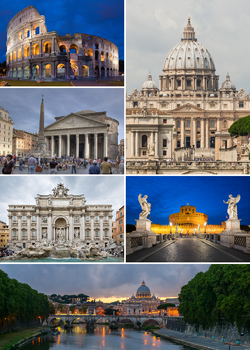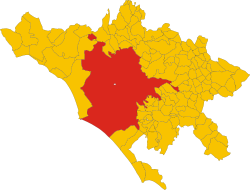Rome
Rome
Roma | |
|---|---|
Capital city and comune | |
| Roma Capitale | |
 Clockwise from top: the Colosseum, St. Peter's Basilica, Castel Sant'Angelo, Ponte Sant'Angelo, Trevi Fountain and the Pantheon | |
| Etymology: Possibly Etruscan: Rumon, lit. 'river' | |
| Nickname(s): | |
 The territory of the comune (Roma Capitale, in red) inside the Metropolitan City of Rome (Città Metropolitana di Roma, in yellow). The white area in the centre is Vatican City. | |
| Coordinates: 41°53′N 12°30′E / 41.883°N 12.500°E | |
| Country | Italy[a] |
| Region | Lazio |
| Founded | c. 753 BC |
| Founded by | King Romulus |
| Government | |
| • Type | Special Comune ("Roma Capitale") |
| • Body | Capitoline Assembly |
| • Mayor | Roberto Gualtieri (PD) |
| Area | |
| • Total | 1,285 km2 (496.3 sq mi) |
| Elevation | 21 m (69 ft) |
| Population (30 April 2018) | |
| • Rank | 1st, Italy (3rd in EU) |
| • Density | 2,236/km2 (5,790/sq mi) |
| • Comune | 2,879,728 [1] |
| • Metropolitan City | 4,355,725[2] |
| Demonym(s) | Italian: romano (masculine), romana (feminine) English: Roman |
| Time zone | UTC+1 (CET) |
| CAP code(s) | 00100; 00118 to 00199 |
| Area code | 06 |
| Website | "Roma Capitale - Sito Istituzionale". Comune di Roma. Retrieved 22 August 2019. |
| Official name | Historic Centre of Rome, the Properties of the Holy See in that City Enjoying Extraterritorial Rights and San Paolo Fuori le Mura |
| Reference | 91 |
| Inscription | 1980 (4th Session) |
| Area | 1,431 ha (3,540 acres) |

Rome (Latin: Roma) is the capital city of Italy. It is also the capital and largest city in the region of Lazio, and the geographical region of Latium. It is on the Tiber River and has 2.8 million people. An estimate by the OECD put the number of people of the city area of Rome at 3.47 million.[3] When the Roman Empire was new, Rome was called the Eternal City because it was already very old.
Rome is well known for being the home of Vatican City, a sovereign state serving as the headquarters of the Holy See having governance over Vatican and the worldwide Roman Catholic Church with the Pope as its head.
History
[change | change source]Nothing is known for sure about the founding of ancient Rome; it is prehistoric. The myth of Romulus and Remus is often told. They were supposedly raised by a she-wolf. Romulus killed Remus, and became the first king of Rome, for some time Romulus ruled alongside a Sabine King a neighboring tribe. There is no historical evidence of this, but the story is popular. Numa Pompilius was the next king.
With the overthrow of the Roman Kingdom began the Republican era. The new Roman Republic fought and conquered the people around it. In 390 BC, the town was invaded by Gauls. Between the third and second century BC, Rome fought against the rival Carthage. The Roman army captured and destroyed Carthage.
Only with Julius Caesar in the first century BC, did the city began to grow significantly, especially toward the Campo Marzio, at the north of Capitoline Hill, and its domain was extended to Britannia. Caesar was never crowned emperor, a title which, however, fell to his adopted son Octavian who took the throne under the name of Augustus.
Augustus "found a city of bricks and left it marble". With him, Rome reached one million inhabitants and this was the first time in history that has happened in the world. Later emperors also added new monuments, temples, and triumphal arches to ancient Rome.
With the decline of the Roman Empire, the city declined in importance and fell into ruin. Pope Gregory I created major reforms for the people. The city was ruled by the pope, and soon also became the capital of a state, the Papal States, which remained active until the 19th century. Popes, like the emperors, became richer over the centuries and the same happened with the counties ruled by them.
Rome experienced a second "rebirth" in importance during the Italian Renaissance. The city of monuments and churches was called the "capital of Christendom", as the home of the Basilica di San Giovanni Laterano, the most important church of the world. The masterpieces of the Renaissance geniuses, like Leonardo da Vinci and Michelangelo, embellished the city.
The power of the Pope lessened along with its state.
But with the Italian Risorgimento Rome experienced a third "rebirth". On 20 September 1870, Garibaldi's army, which had the task of uniting all of Italy under the crown of Savoy, entered the city through a breach opened in the walls at Porta Pia and, the same year, Rome became the capital of the new Italian state. In a few decades Rome grew to be one of the most important capitals of Europe and of the world: in 1936 it was the capital of the Italian Empire, even if for a few years because of the second world war.
Today, Rome is a major European political and cultural center, containing the headquarters of the Food and Agriculture Organization of the United Nations. There are also numerous museums, basilicas and palaces, such as the Colosseum, and, in the Vatican City, St. Peter's Basilica, a brilliant example of the architecture of the Renaissance which can be found all over Rome.
Geography
[change | change source]Rome stands on seven hills, with an area of 1,285.31 km2 (496.26 sq mi). The city is crossed by two rivers: the Tiber, which runs from east to west, and l'Aniene, which runs from north-east to north – within the city, it flows into the Tiber. Rome was built on Sun Hill, later named Palatine. It grew and covered seven principal hills, which are now the inner city of Rome:
Climate
[change | change source]Rome has a Mediterranean climate (Köppen climate classification: Csa), with cool, humid winters and warm, dry summers. Its average annual temperature is above 20 °C (68 °F) during the day and 10 °C (50 °F) at night.
Education
[change | change source]The children in Rome have to go to school from the age of six until 16.[4] This takes them to primary school (Scuola primaria), then middle school (Scuola secondaria di primo grado) and finally high school (Scuola secondaria di secondo grado). The biggest university in Italy is the University of Rome. It was created in 1303. About 200,000 students study at this university.
Transport
[change | change source]Rome has an airport, which is named Leonardo da Vinci International Airport (IATA: FCO). There is a fast train that goes between the airport and the city center, the Leonardo Express, and many commuter railway lines to the nearby suburbs, along with long-distance trains to other cities in Italy. In the city itself, public transport consists of three metro lines (A, B, and C), six tram lines, and many bus routes.
Buildings
[change | change source]Rome has many old, famous buildings. In recent centuries, the city has become an important tourist attraction. At 1,500 fountains, Rome has the most fountains than any other city in the world.[5][6]
- The Vatican
- Cinecittà Studios
- Roman Forum
- Colosseum
- The Temple of Antonius and Faustina (141 AD/CE)
- The Temple of Julius Caesar (29 BC/BCE)
- The Temple of Vesta (7th century BC/BCE)
- The Temple of Castor and Pollux (484 BC/BCE)
- The Arch of Augustus (29–19 BC/BCE)
- The Forum of Caesar (54 BC/BCE)
- The Forum of Augustus (2 BC/BCE)
- The Temple of Venus and Rome (135 AD/CE)
- Circus Maximus
- The Baths of Caracalla (212–216 AD/CE)
- Pantheon
Related pages
[change | change source]Notes
[change | change source]- ↑ Excluding Vatican City which is treated as its own country serving as the headquarters of the Holy See.
References
[change | change source]- ↑ "Statistiche demografiche ISTAT". Archived from the original on 16 July 2018. Retrieved 14 February 2018.
- ↑ "Bilancio demografico Anno 2014 (dati provvisori). Provincia: Roma". Demo.istat.it. Archived from the original on 5 February 2015. Retrieved 13 July 2019.
- ↑ OECD. "Competitive Cities in the Global Economy" (PDF). Archived from the original (PDF) on 14 June 2007. Retrieved 30 April 2009.
- ↑ "Law 27 December 2007, n.296" (in Italian). Italian Parliament. Archived from the original on 6 December 2012. Retrieved 30 September 2012.
- ↑ "5 Facts about Rome's Iconic Water Fountains". John Cabot University.edu. Retrieved 20 July 2024.
- ↑ "The Fountains: Waters of Rome". European Travel. Retrieved 20 July 2024.
Other websites
[change | change source]- Rome – Citizendium
- Ancient Rome first days Archived 21 January 2013 at the Wayback Machine





